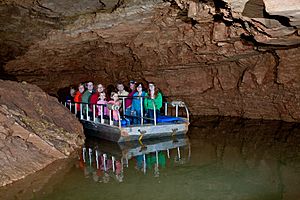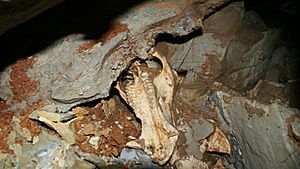Indiana Caverns facts for kids
Quick facts for kids Indiana Caverns |
|
|---|---|

A portion of Indiana Caverns's boat ride
|
|
| Lua error in Module:Location_map at line 420: attempt to index field 'wikibase' (a nil value). | |
| Location | Harrison County, Indiana |
| Nearest city | Corydon |
| Owned by | Private |
Indiana Caverns is an exciting cave system located near Corydon, Indiana. It's part of the much larger Binkley Cave system, which is the longest cave in Indiana. This amazing underground world offers a unique look at geology and ancient animal life.
Contents
Discovering Indiana Caverns
The story of Indiana Caverns began a long time ago. In 1918, a farm near Corydon, Indiana was bought by Arvel H. Miles. Later, a sinkhole (a natural hole in the ground) appeared on the farm. This sinkhole was an entrance to Binkley Cave. People started exploring it in the 1930s.
In 1944, Harvey Binkley bought the farm. The cave is now named after him. Most of the cave's exploration has been done by a group called the Indiana Speleological Survey. They are experts at exploring caves.
Big Bone Mountain Discovery
In 2010, two explorers named Shane Myles and Tim Pride found a new area. They called it Blowing Hole Boulevard. At one end of this area is a huge room, eighty-five feet tall, called Big Bone Mountain. It got its name because many animal bones were found there.
Experts from the Indiana State Museum later studied these bones. They found that the bones belonged to animals from the Pleistocene Ice Age. This was a very exciting discovery!
Connecting the Caves
In 2012, the Indiana Speleological Survey started looking for a connection between Binkley Cave and another nearby cave called Blowing Hole Cave. A passage seemed to connect them, but it was blocked by rocks.
They used special dye in water and smoke bombs to see if air and water moved between the two caves. It worked! This showed that the caves were indeed connected. After some digging, cavers in both caves could even shake hands through the rocks!
This discovery proved that Binkley Cave and Blowing Hole Cave were actually one big cave system. This made the Binkley Cave system about thirty-five miles long. It is now the longest cave in Indiana.
Opening to the Public
Work to develop Indiana Caverns for visitors started on June 1, 2012. Just over a year later, on June 15, 2013, the cave opened its doors to the public.
The Indiana Speleological Survey continues to explore Binkley Cave. They use colored dye in underground waterways to find where water flows. They have found that two local springs are the final destination of unexplored cave passages. Exploring these waterways could add many more miles to the cave's known length. By the end of 2015, the cave was 42.57 miles long, with the potential for at least ten more miles to be discovered in the future.
Geology of the Cave
The Indiana Caverns part of Binkley Cave is mostly found in a type of rock called St. Louis Limestone. This limestone formed a very long time ago during the Mississippian period. This rock layer also has beds of chert and shale. You can see the chert when you take a tour of the cave. You might also spot brachiopods (ancient sea creatures) and coral fossils in the rocks.
How Caves Form
Binkley Cave is a solutional cave. This means it formed when underground streams slowly dissolved the limestone rock. These streams contain carbonic acid, which is a weak acid. The water naturally follows the easiest paths, like cracks and layers in the limestone.
The St. Louis limestone is often "fissile," meaning it breaks easily along flat planes. This weakness helped create the flat ceilings and walls you see in the cave after the cave first formed.
Cave Formations
Water dripping into the cave carries calcium bicarbonate. When this water hits the air in the cave, carbon dioxide is released. This causes calcium carbonate to come out of the water and turn into a solid mineral called calcite.
This calcite then slowly builds up on existing stalactites (hanging from the ceiling), stalagmites (growing from the floor), helictites (curly formations), and sheets of flowstone. This is how these beautiful cave formations grow over time. Other minerals in the water can create different colors like white, red, tan, and gray on the formations and walls.
St. Louis Limestone is mostly made of calcite. But it also contains other minerals like magnesium sulfate, manganese dioxide, ferric oxide, gypsum, dolomite, and aragonite. On the cave tour, you can clearly see deposits of calcite, manganese dioxide, and ferric oxide. The upper part of the St. Louis Limestone layer that the tour goes through includes the Lost River Chert Bed. This layer contains sheets of chert, which is a hard, silicious rock, also visible on the tour.
Ice Age Discoveries
Because Pleistocene animal bones were found in the Big Bone Mountain room, scientists believe that the top of this room once had a large natural opening. This opening likely appeared and closed during the Ice Age.
Scientists used carbon dating to figure out the age of three sets of bones found in the cave. They found that the animals entered the cave around 38,000 years ago. This was about 17,000 years before the last major period of glaciation (when glaciers covered large parts of the Earth).
During the last glacial maximum, huge glaciers stretched past where Indianapolis is today. An earlier glaciation, called the Illinoian, even reached the Ohio River. However, it stopped before reaching the Crawford Upland and the Mitchell Plain, where Indiana Caverns is located. This means that almost all of Indiana's caves are found in a narrow area between Bloomington and Harrison County, which was never covered by glaciers.
Ice Age Animals Found
The Indiana State Museum has identified several types of animals from the Ice Age whose bones were found in the cave. These include:
- Flat-headed peccary: These are ancient pig-like animals. Many of their bones have been found, and you can see some on the tour.
- Northern flying squirrel: This was the first time this species was found in Indiana.
- Southern flying squirrel
- Porcupine
- Passenger pigeon: A bird that is now extinct.
- Barred owl
- Vole
- Garter snake
- Southern red-backed vole
- Black bear
Scientists also found bones from unknown species of a bird, a frog, a fish, and a shrew.


